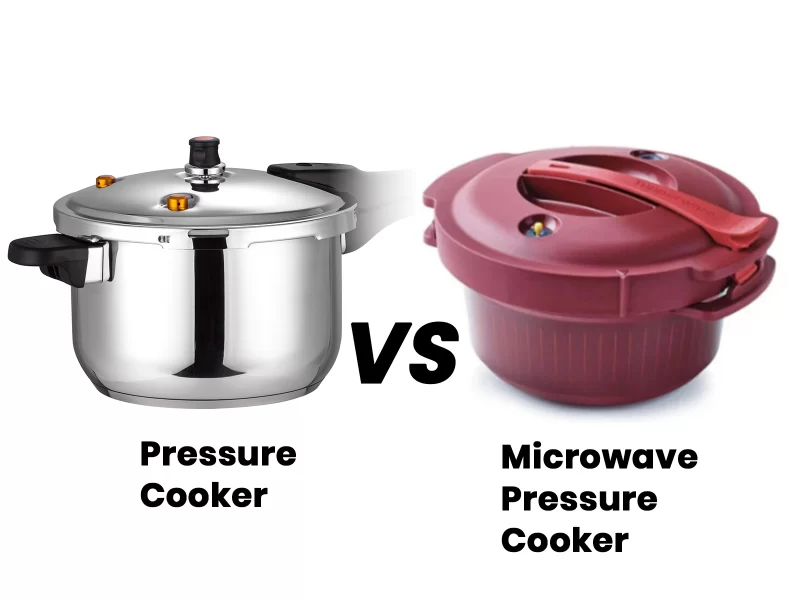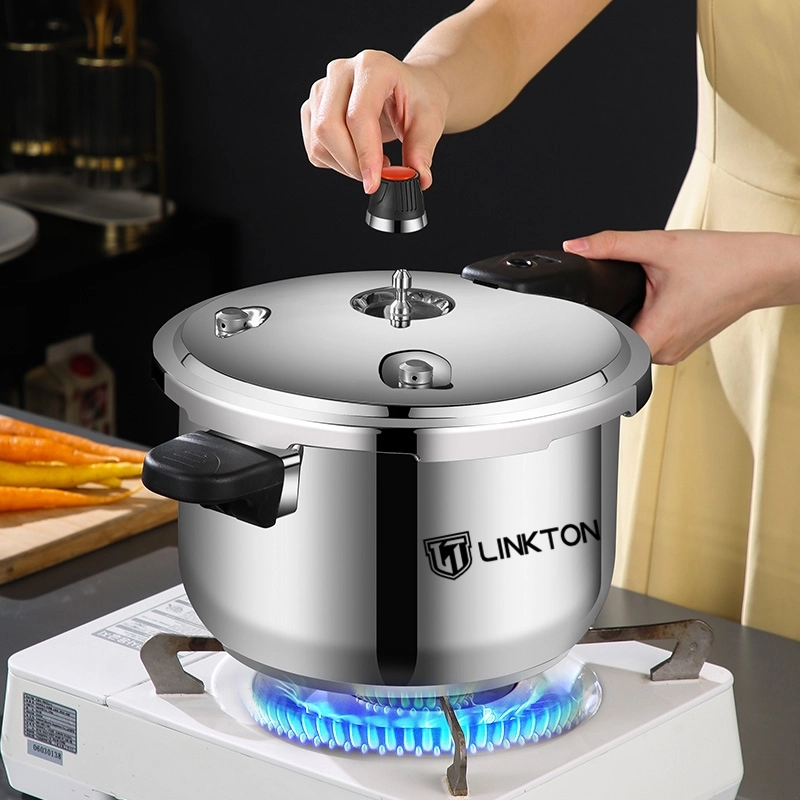
Panelas de pressão e micro panela de pressãos ocupam ambos uma posição importante nas cozinhas modernas. Cada um deles tem caraterísticas únicas, vantagens e cenários de utilização ideais para satisfazer as diferentes necessidades dos utilizadores. Como um fabricante de panelas de pressão Para servir o mercado global, a Linkton fornece este relatório comparativo abrangente para o ajudar a si e aos seus clientes a compreender melhor estes dois fogões.
As panelas de pressão e as panelas de micropressão ocupam uma posição importante nas cozinhas modernas. Tanto as panelas de pressão como as panelas de micro pressão trouxeram grande comodidade à vida quotidiana das pessoas na cozinha. Cada uma delas tem vantagens únicas e cenários aplicáveis para satisfazer as necessidades de diferentes consumidores. De seguida, vamos comparar em profundidade as caraterísticas destas duas panelas.
O que é uma panela de pressão?
Princípio de funcionamento
Panelas de pressão utilizar uma maior pressão de ar para aumentar o ponto de ebulição da água. Quanto maior for a pressão do ar, maior será o ponto de ebulição.
Em circunstâncias normais, o ponto de ebulição da água sob pressão atmosférica padrão é de 100 ℃. A panela de pressão pode selar o calor do vapor de água na panela e aumentar continuamente a pressão na panela para fazer o ponto de ebulição da água atingir cerca de 120 ℃. Este ambiente de alta pressão e alta temperatura encurta significativamente o tempo de cozedura. Especialmente em zonas de elevada altitude, o ponto de ebulição da água diminui, pelo que as panelas de pressão são essenciais para cozinhar corretamente os alimentos.
Vantagens:
- Cozinhar com economia de tempo e eficiência: As panelas de pressão podem cozinhar alimentos difíceis de cozer, como feijão, carne ou cereais. O feijão pode ser cozinhado em 20 minutos e o arroz em cerca de 10 minutos, mantendo um sabor delicioso.
- Poupança de energia: Devido à redução significativa do tempo de cozedura, as panelas de pressão podem poupar muito gás ou eletricidade, o que é benéfico para as despesas familiares e também está de acordo com o conceito de proteção ambiental.
- Retenção nutricional: Por exemplo, no caso da carne, devido ao tempo de cozedura reduzido, ajuda a proteger os ácidos gordos insaturados e a reduzir a produção de substâncias nocivas, como a oxidação da gordura e os polímeros oxidativos.
- Cozinha multifunções: Adequado para estufar, ferver e refogar vários pratos, tornando-o um fogão versátil na cozinha doméstica.
Limitações:
Experiência necessária: A utilização incorrecta das panelas de pressão tradicionais pode causar riscos de segurança, tais como pressão excessiva ou danos na tampa.
Controlo manual do calor e do tempo: É necessário controlar o calor e ajustar o tempo de cozedura
Precauções de utilização
- Ao utilizar uma panela de pressão, é necessário prestar atenção a algumas questões de segurança.
- Antes de utilizar, verificar se o orifício de escape está desobstruído. Pode soprar ar ou observar com uma luz para verificar se a válvula de segurança está intacta para garantir a segurança.
- Não encher demasiado a panela (carne: ≤ 3/4, arroz: ≤ 2/3, papas: ≤ 1/3, feijão e algas: ≤ 1/2).
- Colocar sempre água na panela do arroz e nunca o cozinhar vazio ou seco.
- Antes de aquecer, certifique-se de que a pega da tampa está completamente alinhada com a pega da panela.
- Certifique-se de que toda a pressão foi libertada e que a panela arrefeceu antes de abrir a tampa.
- Não colocar objectos como panos na válvula limitadora de pressão e não bloquear o orifício de escape.
- Evitar reparações não autorizadas ou modificações estruturais.
O que é uma micro panela de pressão?
Princípio de funcionamento
A micro panela de pressão é um dispositivo de cozedura que utiliza alta pressão e baixa temperatura para cozinhar os alimentos. Funciona através da aplicação de alta pressão num recipiente selado e do aquecimento a baixa temperatura para cozinhar os alimentos rapidamente, mantendo os nutrientes dos ingredientes. A pressão de uma micro panela de pressão é inferior à de uma panela de pressão. Uma micro panela de pressão típica funciona a cerca de 40-70 kPa (5,8-10 PSI), mas continua a ser superior à pressão atmosférica, permitindo que a temperatura no interior da panela atinja mais de 100°C.
Vantagens
- Fácil de utilizar: A tampa pode ser aberta em qualquer altura durante a cozedura.
- Cozedura rápida: A cozedura é mais rápida do que nas panelas normais devido a uma melhor eficiência térmica.
- Controlos modernos: Muitos modelos estão equipados com painéis digitais e modos de cozedura predefinidos.
- Conservação dos nutrientes: Uma pressão suave preserva os sabores e nutrientes naturais.
Desvantagens
- Custo mais elevado: Normalmente mais caros devido à utilização de materiais e tecnologias avançados.
- Capacidade mais pequena: Não é adequado para cozinhar em grande escala. Só pode cozinhar uma ou duas porções de alimentos e, se precisar de cozinhar uma grande quantidade de alimentos, terá de o utilizar várias vezes.
- Utilização restrita: Mais adequado para alimentos simples, como sopa, arroz ou papas.
- Mais trabalho de limpeza: Prestar especial atenção à limpeza e manutenção das diferentes peças
- Perigos para a segurança: Algumas microcozinhas de pressão não são feitas de materiais e processos de fabrico sofisticados, o que pode representar riscos para a segurança.
Precauções de utilização
- Não adicionar mais de 2/3 do recipiente com água e não adicionar mais de 1/2 do recipiente com ingredientes facilmente incháveis.
- Verificar se o anel de vedação e a válvula estão desobstruídos e se a tampa da panela está bem fechada e bloqueada.
- Aquecer em lume médio ou brando para evitar uma pressão excessiva provocada por um fogo intenso.
- Abrir a tampa apenas depois de confirmar que a pressão foi completamente libertada para evitar queimaduras.
- Limpe-o atempadamente após a utilização e mantenha o orifício de escape e o anel de vedação limpos.
- É proibido cozer a seco uma panela vazia e esta não pode ser utilizada para fritar alimentos ou vaporizar objectos selados.
Comparação entre a panela de pressão e a micro panela de pressão
| Não é possível abrir a tampa durante a cozedura | Panela de pressão | Micro panela de pressão |
|---|---|---|
| Nível de pressão | 70-90 kPa (pode atingir até 190 kPa) | 40-70 kPa |
| Tempo de cozedura | Mais curto para ingredientes difíceis | Moderado (mais longo para feijão/carne) |
| Segurança | Requer cuidados e atenção | Mais seguro e mais fácil para os principiantes |
| Usabilidade | Feijões, carnes, guisados e cozinha de altitude | A tampa pode ser aberta em qualquer altura |
| Melhor para | Feijões, carnes, guisados, cozinha de altitude | Refeições diárias, sopas, guisados suaves |
| Custo | Acessível | Mais elevado (especialmente os modelos inteligentes) |
| Capacidade | Maior, ideal para famílias numerosas | Normalmente mais pequenos |
| Tecnologia | Funcionamento manual | Frequentemente modos digitais/de predefinição |
Como escolher o fogão certo?
A melhor escolha para uma cozinha eficiente: a panela de pressão
Se tem por hábito cozinhar de forma eficiente e rápida, se tem frequentemente de lidar com alimentos difíceis de cozinhar, como feijão, carne, etc., ou se vive em zonas com baixa pressão atmosférica nas terras altas, então uma panela de pressão pode ser uma escolha mais adequada. As panelas de pressão são capazes de cozinhar os alimentos num período de tempo mais curto, poupando tempo e energia. Ao mesmo tempo, se a exigência de suavidade dos alimentos cozinhados for grande, uma panela de pressão também pode satisfazer essa exigência.
No entanto, se dispuser de mais tempo livre, se quiser cozinhar com requinte, se quiser poder verificar o estado dos alimentos e adicionar temperos a qualquer momento e se tiver determinados requisitos para conservar os nutrientes dos alimentos, então uma micro panela de pressão poderá ser mais adequada para si. Além disso, para quem procura métodos de cozedura diversificados e gosta de experimentar diferentes métodos, tais como ferver, cozer em lume brando, estufar e cozer, as microcozinhas de pressão são mais aplicáveis.
Ideal para cozinhar em casa em grande escala: panela de pressão
Se tem uma família numerosa e necessita frequentemente de cozinhar uma grande quantidade de alimentos de uma só vez, uma panela de pressão pode ser mais adequada para satisfazer as suas necessidades.
No entanto, se a família for pequena e se dedicar a cozinhados delicados, uma micro panela de pressão é uma boa escolha. Entretanto, se houver idosos ou crianças na família que exijam um desempenho de segurança mais elevado, a caraterística da micro panela de pressão de a tampa poder ser aberta em qualquer altura será mais segura.
Em termos de orçamento: as panelas de pressão são mais económicas
As micro panelas de pressão são relativamente caras, especialmente alguns modelos topo de gama com múltiplas funções e menus predefinidos.
Se tiver um orçamento limitado, uma panela de pressão pode ser uma opção mais económica. No entanto, é de notar que, embora as panelas de pressão tenham um preço relativamente baixo, é importante escolher produtos qualificados de canais regulares ao comprá-los para garantir a segurança na utilização.
Porquê escolher a nossa panela de pressão em aço inoxidável?
Como fabricante profissional de panelas de pressãoA nossa empresa é uma empresa de serviços de consultoria, fornecendo soluções completas desde a personalização OEM até à produção em massa para clientes globais. Os nossos produtos têm as seguintes vantagens significativas:

- Material de aço inoxidável de qualidade alimentar, oferece uma variedade de especificações e opções de personalização
- Proteção múltipla da válvula de segurança, estrutura estável, garante uma utilização segura
- Suportar o funcionamento contínuo em cozinhas comerciais, elevada durabilidade
- Cumprir as normas de certificação de vários países no mercado de exportação
Conclusão
Tanto as panelas de pressão como as micro panelas de pressão desempenham papéis importantes nas cozinhas actuais. Linkton, um dos principais fabricantes de panelas de pressão em aço inoxidávelA empresa de marketing B2B, Inc., recomenda que os compradores B2B avaliem os hábitos de cozinha, as preferências de segurança, o tamanho dos lotes e o orçamento dos seus utilizadores-alvo. Quer se trate do tradicional panela de pressão de alto desempenho ou a moderna panela de micro-pressão flexível, a nossa gama de produtos garante elevados padrões de segurança, durabilidade e valor para os seus clientes.
Se estiver interessado em preços por grosso, serviços OEM/ODM ou amostras de produtos, não hesite em contactar-nos diretamente ou enviar um pedido de informação através do nosso sítio Web.
